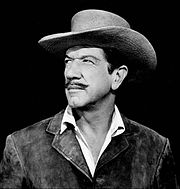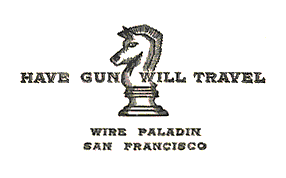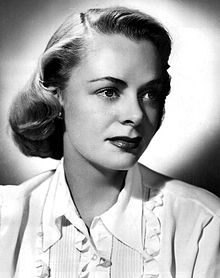Have Gun Will Travel

Have Gun Will Travel: Birds of a Feather
A right-of-way dispute has turned a small town into a seething battleground for two railroads and Paladin intends to settle it one way or another, whoever hires him.
Cast: Richard Boone as Paladin, Kam Tong as Hey Boy, Hal Needham as Cowhand, Stewart East as Townsman and Lisa Lu as Hey Girl.
Have Gun — Will Travel is an American Western television series that aired on CBS from 1957 through 1963. It was rated number three or number four in the Nielsen ratings every year of its first four seasons. It was one of the few television shows to spawn a successful radio version. The radio series debuted November 23, 1958. Have Gun — Will Travel was created by Sam Rolfe and Herb Meadow and produced by Frank Pierson, Don Ingalls, Robert Sparks, and Julian Claman. There were 225 episodes of the TV series, 24 written by Gene Roddenberry. Other contributors included Bruce Geller, Harry Julian Fink, Don Brinkley and Irving Wallace. Andrew McLaglen directed 101 episodes 2, 3, and 19 were directed by series star Richard Boone.
 Have Gun—Will Travel is an American Western television series that aired on CBS from 1957 through 1963. It was rated either number three or number four in the Nielsen ratings during each year of its first four seasons. It was one of the few television shows to spawn a successful radio version. The radio series debuted November 23, 1958.
Have Gun—Will Travel is an American Western television series that aired on CBS from 1957 through 1963. It was rated either number three or number four in the Nielsen ratings during each year of its first four seasons. It was one of the few television shows to spawn a successful radio version. The radio series debuted November 23, 1958.
Have Gun—Will Travel was created by Sam Rolfe and Herb Meadow and produced by Frank Pierson, Don Ingalls, Robert Sparks, and Julian Claman. There were 225 episodes of the TV series, many of them written by Gene Roddenberry); 101 were directed by Andrew McLaglen and 19 were directed by series star Richard Boone.
Title
The title was a catchphrase used in personal advertisements in newspapers like The Times, indicating that the advertiser was ready for anything. It was used in this way from the early 20th century. A form common in theatrical advertising was “Have tux, will travel,” and this was the inspiration for the writer Herb Meadow. The TV show popularized the phrase in the 1960s, and many variations of it were used as titles for other works such as Have Space Suit—Will Travel by Robert Heinlein.
Opening sequence
 Originally, each show opened with exactly the same 45-second visual. Over a slow four-note-repeat backbeat score, a tight shot of a white chess knight emblem centered in a black background is shown. The view widens to show that the knight is actually an emblem affixed onto the black pistol holster of a gunman, clad entirely in black, who is standing with right side to the camera, and his left hand in the pistol belt. Only his midsection, showing the full gun holster, is seen. Paladin’s right hand then slowly draws the weapon, a long-barreled revolver, from the holster, leisurely cocks it, and then rotates it to point the barrel exactly at the viewer, for 10 seconds. During this time, Paladin delivers a pointed line of dialogue from the coming episode (since the speaker’s face is never seen, this is possible to do with the same visual, in each episode). Then the pistol is again leisurely decocked, and reholstered with an angry brusqueness, which also serves as emphasis for the previous short speech. As soon as the weapon is reholstered, the view again tightens to show only the chess knight, and “RICHARD BOONE in HAVE GUN—WILL TRAVEL” appears. This leads into the show’s theme music. In the actual episode that followed, the line delivered at gunpoint in the opening sequence is usually notdelivered in this way. In Season 1’s “No Visitors,” the line does not occur in the story at all.
Originally, each show opened with exactly the same 45-second visual. Over a slow four-note-repeat backbeat score, a tight shot of a white chess knight emblem centered in a black background is shown. The view widens to show that the knight is actually an emblem affixed onto the black pistol holster of a gunman, clad entirely in black, who is standing with right side to the camera, and his left hand in the pistol belt. Only his midsection, showing the full gun holster, is seen. Paladin’s right hand then slowly draws the weapon, a long-barreled revolver, from the holster, leisurely cocks it, and then rotates it to point the barrel exactly at the viewer, for 10 seconds. During this time, Paladin delivers a pointed line of dialogue from the coming episode (since the speaker’s face is never seen, this is possible to do with the same visual, in each episode). Then the pistol is again leisurely decocked, and reholstered with an angry brusqueness, which also serves as emphasis for the previous short speech. As soon as the weapon is reholstered, the view again tightens to show only the chess knight, and “RICHARD BOONE in HAVE GUN—WILL TRAVEL” appears. This leads into the show’s theme music. In the actual episode that followed, the line delivered at gunpoint in the opening sequence is usually notdelivered in this way. In Season 1’s “No Visitors,” the line does not occur in the story at all.
The first season’s Christmas episode, “The Hanging Cross,” is unique. Instead of drawing the revolver, Paladin unbuckles the belt and removes the entire rig, holding it out to the camera as he talks. The camera then tilts upward, revealing Richard Boone himself speaking to camera, then hanging the belt, holster, and gun on a wall peg and walking away as the theme picks up and the title graphics appear.
In a later version of the opening sequence, there is a longer range shot, with Paladin in a full-body profile silhouette, and he fast-draws the revolver, dropping into a slight crouch as he turns and points it directly at the camera. After the dubbed-over line, he straightens back up as he shoves the firearm back into his holster. This silhouette visual remained for the rest of the run of the series, but in later episodes, the spoken line would be dropped.
Filming locations
 Unlike many other westerns, entire episodes were filmed outdoors and away from the Paramount Studios backlot. Beginning in season four, filming locations were often given in the closing credits. Locations included Bishop and Lone Pine, California; an area now known as Paladin Estates between Bend and Sisters, Oregon); and the Abbott Ranch near Prineville, Oregon.
Unlike many other westerns, entire episodes were filmed outdoors and away from the Paramount Studios backlot. Beginning in season four, filming locations were often given in the closing credits. Locations included Bishop and Lone Pine, California; an area now known as Paladin Estates between Bend and Sisters, Oregon); and the Abbott Ranch near Prineville, Oregon.
Characters – Paladin
The show followed the adventures of “Paladin,” a gentleman gunfighter (played by Richard Booneon television and by John Dehner on radio) who preferred to settle problems without violence; yet, when forced to fight, he excelled. Paladin lived in the Hotel Carlton in San Francisco, where he dressed in formal attire, ate gourmet food, and attended the opera. In fact, many who met him initially mistook him for a dandy from the east. But when working, he dressed in black, carried a derringer under his belt, used calling cards with a chess knight emblem, and wore a stereotypical western-style black gunbelt with the same chess knight symbol in platinum attached to the holster.
The knight symbol refers to his name—a nickname or working name—and his occupation as a champion-for-hire. The theme song of the series refers to him as “a knight without armor.” In “The Road to Wickenburg,” Paladin draws a parallel between his methods and the chess piece’s movement: “It’s an attack piece, the most versatile on the board. It can move eight different ways, over barriers, and [is] always unexpected.” Paladin’s routine switch from the expensive light-colored suit of his genteel urbane persona in San Francisco to his alter ego, who wears all-black attire for forays into the lawless and barren Western frontier, is also a chess reference. The chess knight also appears on his iconic business card, which inspired the quip “What’s Paladin’s first name?” “Wire, of course—look at his card!”
Paladin was a former army officer and a graduate of the United States Military Academy at West Point. He was a polyglot, capable of speaking any foreign tongue required by the plot. He also had a thorough knowledge of ancient history and classical literature and exhibited a strong passion for legal principles and the rule of law. Paladin was also a world traveler. His exploits had included an 1857 visit to India, where he had won the respect of the natives as a hunter of man-eating tigers.
Paladin took on his role by happenstance, as revealed in a flashback during the first episode of the final season (“Genesis,” episode 193). To pay off a gambling IOU, he had been forced (by his creditor, who obliquely referred to his “distinguished family name”) to hunt down and kill a mysterious gunman called Smoke (played by Boone without his moustache and with grey-white hair). When they meet, Smoke gives the Paladin character his nickname, facetiously calling him “a noble paladin” after a well-meaning but mercenary medieval knight. This turns out to be doubly ironic, as Smoke reveals in his death scene that he had not been a criminal gunfighter but instead had protected the nearby town from the man who had sent Paladin. During a funeral service in the town, it becomes clear that Smoke was indeed the protector of the townspeople. At the end of the episode, Paladin adopts Smoke’s black outfit and confronts the other man (portrayed by William Conrad, who also directed the installment). It is implied that Paladin kills him, thus protecting the town. The episode was unusually allegorical and mythical for a popular western in 1962.
 Paladin charged steep fees for his services—typically a thousand dollars a job, a small fortune at the time. His primary weapon was a custom-made .45 caliber Colt Single Action Army revolver that was perfectly balanced and of excellent craftsmanship. It had a one-ounce trigger pull (virtually impossible to achieve reliably with the Colt lockwork; most SAA’s are four to eight pounds, not ounces, and a one-ounce pull would be very dangerous) and a rifled barrel with the rifling unaccountably stated in the show as though it were a special feature, though all SAA’s had rifled barrels unless specially made for shot cartridges. The accuracy was given as “one inch to the right at fifty feet” though such a large error in windage surely would have been corrected on a custom-made Colt.
Paladin charged steep fees for his services—typically a thousand dollars a job, a small fortune at the time. His primary weapon was a custom-made .45 caliber Colt Single Action Army revolver that was perfectly balanced and of excellent craftsmanship. It had a one-ounce trigger pull (virtually impossible to achieve reliably with the Colt lockwork; most SAA’s are four to eight pounds, not ounces, and a one-ounce pull would be very dangerous) and a rifled barrel with the rifling unaccountably stated in the show as though it were a special feature, though all SAA’s had rifled barrels unless specially made for shot cartridges. The accuracy was given as “one inch to the right at fifty feet” though such a large error in windage surely would have been corrected on a custom-made Colt.
The lever-action Marlin rifle strapped to his horse’s saddle was rarely used, but the horsehead insignia embossed on the rifle’s stock suggests this weapon was as meticulously crafted as the six-shooter. The derringer (a double-barrel Remington in most episodes, a single-barrel Colt in some) that Paladin hid under his belt saved his life numerous times. Paladin’s intuitive sense of chesslike strategy—often anticipating moves ahead of his adversary and backing it up with formidable skills in all areas of personal combat—plus his epicurean tastes and implied lust for women (when relaxing in San Francisco) made him very much a “James Bond” of the old west. Ever a man of refinement, Paladin even carried a few expensive cigars in his boot when out on adventure.
Paladin’s great advantage over adversaries was not his impressive equipment or even his ability as a marksman, superior as that was; Paladin’s edge was his rich education and tactical sense. He had an infallible ability to relate ancient antecedents to his current situations. When the enemy was surrounding him, Paladin could usually make some insightful quip about General Marcellus and the siege of Syracuse or something similar and then use this insight to his advantage. Burying a rancher killed by Indians, he recited John Donne‘s “Death Be Not Proud” above the grave. In other episodes he quoted lengthy Shakespearean passages from memory. A male role model who memorized poetry was unique in a 1950s television series. Like a chess master, he sought control of the board through superior position and usually killed only as a last resort.
In the final episode of the radio show, Paladin returns to the east to claim a family inheritance. In the 1972–74 series Hec Ramsey, set at the end of the 19th century, Boone stars as an older former gunfighter turned early forensic criminologist. At one point Ramsey denies that, in his younger days as a gunfighter, he had worked under the name Paladin. The origin of this myth is Boone’s remark in an interview, “Hec Ramsey is Paladin—only fatter.” Naturally, he merely meant the characters had certain similarities: Ramsey, for his part, was practically buffoonish, imparting a measure of humor to Hec Ramsey missing from the erudite Paladin.
In the two-part 1991 TV mini-series, The Gambler—The Luck Of The Draw, a poker game is played by the rules of “the late Mr. Paladin” in the hotel where Paladin usually stayed. Alas, Paladin had finally died.
The one other major semiregular character in the show was the Chinese bellhop at the Carlton Hotel, known as Hey Boy, played by Kam Tong. According to author and historian Martin Grams, Jr., the character of Hey Boy was featured in all but the fourth of the show’s six seasons, with the character of Hey Girl, played by Lisa Lu, replacing Hey Boy for season four while Kam Tong pursued a career with another television series.
Lu appears in the 1957 episode “Hey Boy’s Revenge,” playing Hey Boy’s sister, Kim Li. In that episode, the audience also learns that Hey Boy’s name is Kim Chan. (We also learn that Paladin can read Chinese in at least a rudimentary way.) In another episode from the first season, “The Singer,” Hey Boy responds to a stranger who addresses him with “Hey you!” by annoyedly responding that it is “Hey Boy” and not “Hey you.”
In the season/episode sequencing used by Netflix, Kam Tong (Hey Boy) did actually appear in three episodes of Season 4: episode 1 (“The Fatalist”), episode 2 (“Love’s Young Dream”), and episode 9 (“The Marshal’s Boy”).
Guest stars
June Lockhart appeared twice in the role of Dr. Phyllis Thackeray. Her first appearance was in the episode “No Visitors.” In “The Return of Dr. Thackeray,” which aired May 17, 1958, Paladin’s physician friend diagnoses a cook with smallpox. Dr. Thackeray worries that the disease will infect the nearby ranch hands employed by wealthy ranch owner Sam Barton, played by Grant Withers, because Barton refuses to permit his workers to be vaccinated. Singer Johnny Western, who performed the series theme song, appears in this episode as an angry gunslinger.
Kevin Hagen appeared five times on the series, long before he was cast as the kindly Dr. Hiram Baker on Michael Landon‘s Little House on the Prairie.
Theme songs
 The program’s opening theme song was composed and conducted by Bernard Herrmann. Its closing theme song, “Ballad of Paladin,” was written by Johnny Western, Richard Boone, and Sam Rolfe and was performed by Western.
The program’s opening theme song was composed and conducted by Bernard Herrmann. Its closing theme song, “Ballad of Paladin,” was written by Johnny Western, Richard Boone, and Sam Rolfe and was performed by Western.





